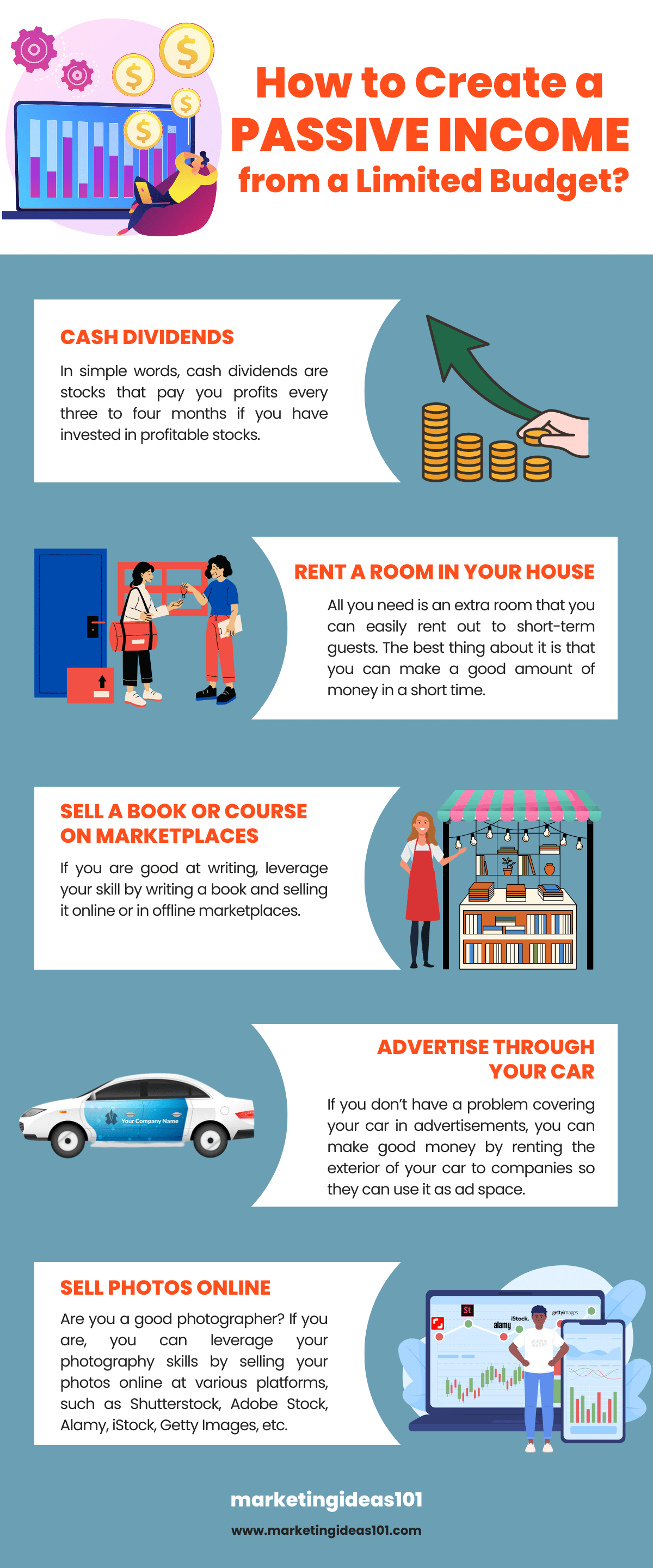Table of Contents
How to Generate Passive Income?
Generating passive income might sound like a challenging task, but you can easily create an excellent source with the right plan in mind and proper knowledge. So, if you are ready to walk on the road to financial freedom, check out the following passive income sources:
1. Writing an eBook
The basic idea is you invest in the writing and development of the eBook and then continue to get income on an ongoing basis from royalty sales.
-
Getting the Topic Right
The first thing most people ask is how to market their eBook and get sales. Yes, that’s important, but the first and most important step is picking the right topic. You will need a niche you can target that will allow you to get your eBook noticed.
-
What to Look for in a Topic
Start by finding a topic that your readers ‘want.’ There are ways to learn what your readers are interested in reading. The best way is through the existing communication channels you have with your target audience. Perhaps that is customers you’re already working with, a blog you have, a podcast, or other interactions. It would help if you listened to your potential audience, heard their interests, and developed topics based on that.
Suppose you don’t have a blog or other avenue of communicating directly with your potential target audience. In that case, you will need to get busy on Google and start researching your areas of expertise and see where the opportunities might be to develop a book that will interest your audience.
Find where your audience gathers online, possible competitor eBooks, etc., to determine the current status of your niche.
-
Putting Out a Survey
If you have a forum to interact with your audience, you can always put out a survey for your followers. Be sure not to be too obvious and have your survey ask questions like “What do you think I should write to boost my passive income?” directly! Neither should you go for questions like “What do you want me to write about?”
Ask your audience about their areas of interest, their concerns, what they would like to know more about, and their needs. This discussion may help to give you clues on what might be popular in an eBook format.
Without the right topic, it’s going to be challenging to find success. Your chosen topic also needs longevity and should be evergreen in nature so that sales can continue for an extended time.
-
Scout the Competition
Once you have developed a few ideas that you feel can work, you need to research your potential competition. If you have direct competitors, try and find an angle or a niche that they don’t cover that you can focus on to help differentiate your eBook and stand out to your target audience.
-
Get Published!
There is no shortage of platforms that allow you to publish eBooks and make money out of them. However, choosing the right platform is very important as you’d want your eBook to be available on a platform that is used widely.
The first name that comes to most people’s minds is Amazon, accounting for roughly 80% of the total eBook sales (in English-language countries). Publishers get a 70% royalty on their Kindle titles (for eBooks priced between $2.99-$9.99), while anything priced below $2.99 and above $9.99 would get you 35% on the gross sales price. Publishing eBooks on Amazon is pretty straightforward, and plenty of information is available from Amazon.
Some other prominent platforms include Apple iBooks Author (70% flat royalty, requires iTunes Producer, Mac-only), Kobo Writing Life (190 countries), Smashwords, Digital2Draft, Inkshares (US), Unbound (UK), and Gumroad.
-
Get Noticed!
Most eBook publishers don’t have the budget required to advertise their eBooks using traditional advertising channels. However, you don’t have to be an expert in online marketing either, as you can do a lot using the existing channels, primarily for free!
You might not have a blog of your own, but if you do, there is simply no excuse not to use it for marketing your eBooks. There are a ton of eBook plugins available that make it super easy to integrate eBook sales with your blog. If you don’t already have a blog, it doesn’t take much effort and money to start one.
Social Media is another powerful channel that allows you to reach the masses. If you are lucky enough to have a strong following on social media, you should definitely take advantage of what platforms like Facebook and Twitter offer. If the target audience of your eBooks is business people or students, LinkedIn can be particularly useful in spreading the word out.
If you don’t already have social media accounts, at least on the most popular sites, where have you been? Getting started is just a matter of a few clicks, and it doesn’t hurt to reach out to people you already know.
In addition to the eBook publishing platforms discussed before, many helpful sites can help you promote and distribute your eBooks. While many such services are available for free, you’d want to go the paid route if you are really serious about generating a steady passive income by selling eBooks.
2. Amazon FBA
Amazon is known as one of the best online platforms for creating several opportunities to make a passive income. If you have a product to sell online, you can use Amazon. It is a vast marketplace with great potential. According to Semrush, Amazon is the fourth most visited site in the USA[i].
In addition to selling directly on Amazon, it also offers a couple of other fulfillment strategies, such as the “Fulfillment by Amazon” (FBA). The best thing about FBA is that you don’t have to worry about a thing. From picking to packing to shipping, everything is managed by Amazon.
Amazon has more than 175 fulfillment centers worldwide that comprise more than 150 million square feet of storage space[ii]. In addition to your products being managed by Amazon, you also get fantastic customer service and returns that can help scale your business.
Following are a few steps that you can follow to make passive income through FBA:
- First of all, find the best product to sell. It should be something that has a good demand but is not commonly available in the offline market.
- Find the suppliers of the product that can deliver you in bulk (at a reasonable price). Remember that you need to buy low and sell high to make a profit.
- Click high-quality photos of these products and list them on Amazon through your seller account.
- Set the prices, but make sure to set them right. You have to be on the top to make a passive income and going to that place takes a lot.
- Use an attractive product title and description on the product page.
- Ship all your products to your nearest Amazon fulfillment center.
- From here, Amazon will take all the responsibility for the packaging, labeling, and shipping of your products through FBA.
- Amazon will collect the payment, deduct their fees, and transfer the remaining amount to your account twice per month.
Once you have successfully launched your business online, amazon has several tools to help you scale up your business. In addition, Amazon’s online advertising solutions provide you with an excellent option to reach and engage with a broad audience.
Note: Although the sales might be passive, the work is not. Therefore, you should always keep your products and things updated to stand out.
Following are some things that you should try in your first three months as an amazon seller:
- Keep in touch with your account’s health in the Seller Central.
- Offer deals/coupons or use the advertising options to boost your sales.
- Create engaging content or enroll in Brand Registry.
- Expand your product range by listing more products (only if you can manage).
- Use the option of Automate Pricing Tool in Seller Central.
3. Affiliate Marketing
Affiliate aka associate program or pay-per-action is an agreement between you and the merchant that qualifies you for earning a commission on every sale (most programs pay you after an actual sale). Your blog links to the merchant and requires the visitor to perform a certain favorable action, including buying something, filling out a form, or providing other information.
Amazon affiliate program is a prime example of such programs, which assigns unique Associate IDs based on which commission is calculated and paid.
-
How to Earn a Passive Income with Affiliate Links?
Affiliate links work great for blogs and sites that already have some regular traffic. Even if you don’t own a blog yet, it’s not hard to start a new one. However, you need to pump some quality content and focus on generating Google and social media traffic. Earning through affiliate programs is probably one of the easiest ways to generate passive income, as you don’t have to deal with physical products yourself or spend countless hours writing an eBook.
-
How Do Affiliate Programs Work?
Here is how it works: People come to your blog or site looking for some information. Along with the relevant content, they can also see affiliate links to relevant products, which can be anything ranging from physical products to online tools and resources. Affiliate fees/commissions vary greatly from niche to niche, which means it makes more sense to affiliate with niches that have better affiliate program setups, such as online courses and hosting providers.
You’d come across many affiliate sites/programs during your search, and choosing the right one depends on different factors, such as your niche. For example, LinkShare and CJ Affiliate (formerly Commission Junction) are among the largest pay-for-performance networks that work great for publishers and advertisers. Some other popular programs include ClickBank, Amazon.com, AvantLink, eBay, and ShareASale.
-
Choose the Right Niche
The most critical element in the affiliate business is the blog/website itself, focusing on a specific niche instead of ‘trying to be the jack of all trades. A website should only be affiliated with the products or services from the same niche. The web traffic comes to your site trusting your opinion, and if you are affiliated with something irrelevant, they might turn away instead of being convinced and clicking your affiliate link. You might also have trouble getting traffic if you cover general topics such as general technology or a marketing blog.
A niche should have at least 50 products; otherwise, you may find yourself looking for other more profitable niches. EBooks, online courses, and other digital goodies are some of the most profitable products to affiliate with, which might come as a surprise for those who think affiliating with Amazon is the best option.
Your blog/site should not be the only place to host affiliate links. You can also promote them with stuff such as free eBooks, email marketing, and autoresponders.
If done properly, affiliate marketing has the potential of turning into a lifetime passive income stream and is much more than a one-time commission. Finding the right niche, products, and merchants is the key to success. Earning money by helping others find quality products is something like a marketer’s dream comes true. A lifetime (or long-term) affiliate program offers better growth and more money but requires constant hard work and thinking from the customer’s perspective.
4. Mobile App Development
Developing a mobile application might be a big thing as it is time-consuming and requires some investment, but once it is up and alive, you will reap its rewards over time. The app might be a game or anything helpful. Once it goes public, users can download it, and you can generate an excellent passive income.
There are several ways to generate a passive income through your mobile app, for example, through affiliated ads, in-app purchases, subscriptions, etc.
If your app gains popularity over time or receives positive feedback, you can gradually add more features to keep it updated and on the top. You can also market the app on various social media platforms or advertise it online if you have a budget available.
Risk
The biggest risk of developing a mobile app is that the market is already crowded and saturated. The vast number of apps means only a truly successful app can offer something valuable to the users. Moreover, the popularity of a mobile application can be short-lived, too, which means your passive income can dry out a lot faster if the users start leaving the application over time.
5. YouTube Channel
YouTube provides an excellent opportunity for content creators to upload their videos on the platform and earn good money. You need to be at least 18 years old or have a legal guardian to receive the payments via AdSense. However, you need to create content that meets the advertiser-friendly content guidelines.
Before you are accepted into the YouTube Partner Program, Google reviews your channel to allow the connection of AdSense with your channel. Your channel can be monetized even if it doesn’t have millions of subscribers and views. YouTube income depends on many other things, such as user engagement, ads played on your video, the niche you are working in, etc.
Popular YouTubers first build their audience in millions, and then they may launch their own merchandise to earn more passive income.
In addition to generating passive income through ads, you can partner with different brands and sponsor their content for a good amount of money. Brands spend a massive chunk of their advertising budget on influencers, especially YouTubers, who have already won their viewers’ loyalty.
In short, you can generate passive income through YouTube in the following ways:
- Advertising revenue
- Channel memberships
- Sponsorships
- Super Chat and Super Stickers
- Merchandise
- YouTube Premium Revenue
The thing most contributors like about YouTube is that you can leverage this platform for free and use your great content to build a big audience.
6. REITS
REITs started in the United States and then became popular in Asia. The US Congress created REITs in 1960 when President Eisenhower signed the REIT Act. REITs were contained in the Cigar Excise Tax Extension of 1960 to give everyone a chance to profit from investing in income-producing real estate. REITs enable anyone to have ownership of a property by purchasing stocks similar to how they invest in businesses.
What is a REIT?
So, what is REIT or Real Estate Investment Trust? REITs own and operate income-generating real estate assets, including offices, apartment buildings, hotels, warehouses, shopping centers, and highways.
How does a REIT function?
A REIT is funded by pooling investors’ money to buy commercial or residential buildings that are professionally managed. The company then gains income from the rent of its tenants and shares the income with the investor’s portion of the profit.
A REIT usually gains income from lease installments or interest on real estate debt. You own a share of the mall, office, warehouse, hotel, or apartment, but you don’t own a tangible item directly. As an investor, you get exposure to real estate without having the daily work of operating, owning, and financing the properties.
REIT Guidelines
The most important thing to know about REIT is that 90% of its taxable income must be distributed every year, so investors get regular and equal dividends. You can check other guidelines here www.sec.gov/fast-answers/answersreitshtm.html if you are from the US.
Unlike typical corporations, a REIT is exempted from corporate taxes as long as it satisfies the requirements from SEC. But investors must still pay taxes on the dividends as part of their personal income taxes.
Different types of REITs
These are the two categories of REIT.
-
Equity REIT
The type of REIT puts investment in and own income-producing real estate properties and gives investors the chance to put resources into these portfolios. However, as mentioned earlier, they must distribute at least 90% of the portfolio’s income to its shareholders in the form of dividends.
-
Mortgage REIT
This type of REIT offers financing to incoming-producing real estate by giving home loans and home credit and gaining from the interest of the investments.
Investing in REITs
Real estate investment trusts can offer investors stability, value, and solid returns. One of the great things about a REIT is that it provides both income and capital gain. In addition, it offers diverse benefits over time. Since REITs own real assets, they also offer some security for inflation. When inflation comes, typically rents on apartments, prices of hotel rooms, commercial lease space, etc., also increase, and so does the income you receive from your REIT.
Moreover, it is also has a high dividend payout according to a Nareitre search (a leading REIT research organization). Dividends and share price appreciation are two ways to make money from a REIT.
Since REITs function like it, investing in REITs requires the same due diligence as what you do with stocks. It gives the investors the benefits of real estate exposure along with the exchangeability of public-traded stock.
7. Asset Rentals: Rent Stuff You Own
A full-time, nine-to-five job doesn’t seem to be enough to sustain a families’ basic. More and more people are looking for additional options to earn income using the resources they have at hand. One option is to consider renting assets you already open. There are new clever ways to turn your unused stuff and space into passive income.
What Is Peer-to-Peer Renting?
Peer-to-peer renting is a concept where people can share their things with someone else (their peers) while earning money simultaneously. This rental concept can range from unused camping gear to an unused bicycle.
Renting out your items allows those who can’t afford to buy their own or only have occasional need to get easier access to those items. It is a practical idea that makes the most out of available assets.
The idea has become more popular as various peer-to-peer renting online platforms have emerged. It provides both parties with a platform to meet and transact securely and more efficiently. If you are planning on getting into the business of peer-to-peer renting, here are a few things you can rent out:
-
Rent Out Your Car, Motorcycle, or Bicycle
Reliable transportation is a critical day-to-day need for just about everyone. When it comes to earning extra income through peer-to-peer renting, car renting can give you the best option for a return on your investment.
Renting out a car can be a scary thing to do, though. Apart from the fear of it getting damaged or broken, you may also fear that it will be stolen, which can also cause stress. That sounds scary and problematic, but the good thing is that many peer-to-peer car-renting companies and websites can provide solutions to your concerns and help keep the process as passive as possible.
So, if you have a car sitting in your garage and you aren’t driving often, then it is perhaps the time to use it and earn a few bucks at the same time. To start, look for a company that can help you connect with nearby people who are in need of a car.
On the other hand, if you don’t have a spare car, a motorcycle or a bicycle can also work.
-
Rent Out an Unused Room in Your House
Traveling is something we all love to do, and it seems to only get more expensive. The reality is even one or two nights’ stay in a nice hotel can be out of reach. With services such as Airbnb and others, you can easily rent out a spare room, a guest house, the room above the garage, or even your whole home while you’re on vacation.
Companies like VRBO and HomeAway can help you advertise and find guests to rent your space. With the idea gaining popularity, you will need to research the market and see how your space stacks up to others in the area.
-
Rent Out a Little Space in Your Garage
If you have a garage, does it have some extra space? Do you know someone who needs extra storage? That’s a perfect opportunity to make a little income off something you already have. Make sure you’re aware of what you’re storing and ensure that your insurance will cover the items should they be stolen for some reason.
-
Rent Out Your Unused Travel Luggage
Good high-quality travel luggage can be quite expensive, especially if you need to go on longer trips. Purchasing brand new travel luggage may not be a wise decision, especially if you will only use once in a great while. As a result, some rent luggage and pay a lower price instead of buying their own. If you have some great luggage just sitting idle, then consider renting it out for use.
Check out online platforms such as Rent Luggage and Platform 13 to facilitate the process. Luggage renting websites can aid you in searching for your first renter and are a great way to ensure your items will return and be free of damage.
-
Clothing
If you have to attend a special event, dress up for that special night out, or want something different to wear, you might have a sticker shock at the attire needed. Likewise, you may have bought a few outfits along the way that sit idle. Why not consider renting them out for an affordable price? To start, you can look up different peer-to-peer renting websites online that offer clothing rental.
Some of the well-known sites are Style Lend and Rent the Runway. These services facilitate the process of renting, getting paid, and helping to ensure your items don’t get damaged or stolen.
-
High-Definition Camera and Equipment
High-definition, high-quality cameras, and related equipment are also in great demand and are expensive. The equipment can be used for special occasions such as weddings, corporate events, and even special travel trips. If you have a spare professional camera and equipment such as DSLRs, GoPros, Under-Water Action Cameras, Tripod, or Camera Drones, why not earn some cash by renting it out. You can begin with peer-to-peer renting online platforms such as KitSplit, Cameralends, and ShareGrid.
Renting out assets is a great way to make income off existing things you own passively. In today’s internet-driven world, there are many options to facilitate making your items available for others to use easily, and you make money in the process.
8. Selling Online Courses
Selling online courses has become a great way of generating a steady passive income stream. Not only can you sell online courses in your niche, but you can also serve as an affiliate for other people who are offering their online courses.
Online courses here refer to membership-only and multimedia-driven courses for which customers have to sign up and pay a fee. Although developing and maintaining online courses can be quite a daunting task initially, with the right courses, you can make a lot of money in the long run.
Who Should Create Online Courses?
It might not sound very encouraging, but online courses aren’t everybody’s cup of tea and might not work for all businesses and individuals. You should only consider developing your own course if you believe you can solve your target audience’s problems and offer something of value.
Suppose you have something (based on education, experience, skills, etc.) that can help people solve their problems or help them learn something new. In that case, you should consider developing and selling online courses.
The Nuts and Bolts of Building Online Courses
-
Define the Unique Selling Proposition
You might not be sure what to do at first, but that shouldn’t distract you from setting everything straight. Instead, talk with your target audience and try to understand their problems and how you can contribute to making their lives better. Being clear about the transformation your course can bring is the key selling point and will help you clearly communicate with your students what they would get.
Things become clear after defining the transformation as your target audience isn’t just looking for the great information. On the other hand, if you find it difficult to clearly define a transformation, then it’s probably time to rethink if you should really be getting yourself into selling online courses.
-
Content Brainstorming
Brainstorming is essentially an extension of defining a transformation and involves figuring out the details that lead to the defined transformation. By brainstorming, you can establish the core information, case studies, exercises, etc., that you want to include in your online courses.
Everyone has their own way of brainstorming. Some like Post-it notes while others prefer keeping everything digital. Whatever methods you choose, it’s essential to keep everything organized; otherwise, you might end up throwing everything into notes and not prioritize anything.
-
Thought Organization
Once you have figured out the details, it’s time to put everything in order, which involves organizing ideas and notes into hierarchies or modules. Organization includes deciding what comes first and stuff you don’t need. The critical thing to remember is to see through your students’ eyes and how they expect to go along with the course. The organization of brainstormed ideas also allows you to cover holes and identify missing topics.
-
Course Outlining
Preparing a course outline involves reviewing the ideas and notes you have already organized. However, at this stage, you’d want to share the outline with others for feedback from fans, colleagues, or even friends and family. You might not like some of the feedback but should be willing to kill some of your genius ideas that aren’t necessary. A course outlining and feedback provides you with the opportunity to trim unnecessary lessons and stick to content that can assist the transformation.
-
Pre-selling
Pre-selling outlined courses to your target audience (in a limited number) greatly helps validate what your course is trying to accomplish. If people aren’t showing interest at this stage, you probably need to start the cycle again.
However, not everyone has a strong fan base, so you might want to run ads for webinars or get active on social media to pre-sell your courses.
-
Communicating with the Target Audience
Your customers should never feel like you sold a course and left, and they should not be left wondering what happens next. Keeping the pre-sale customers updated ensures great onboarding, which is only possible through clear and regular communication.
If you don’t have your landing page yet, communicate through social media or other private channels, but it is important to keep them up to date.
-
Course Production
This step takes the most time and effort. It also involves planning the content and which options to include, such as videos, audios, images, and text. Planning what and when to include is easy, but sticking to those plans can become complicated, especially if you are already time strapped. That’s why doing one lesson at a time makes sense. While videos have become the default method of delivering online courses, you can also opt for audio or text if you are on a tight budget.
In addition, developing exercises and action items at the end of each lesson helps reinforce the material and improves the learning experience.
-
Setup up Feedback Collection
After setting up the course, you’d want to collect feedback from your students. Online surveys and emails might be the most convenient and cost-effective methods of collecting feedback, but nothing compares to one-on-one and group conversations. It’s a good idea to ask for testimonials while collecting the feedback, as the more testimonials you collect, the easier it would become to build trust.
-
Course Refinement
The feedback you collected earlier allows you to refine the existing courses and adds even more value to them. Add more valuable content, remove the unnecessary fluff, and refine the course to make them even better. You can also refine the sales page and include testimonials you have collected at the feedback stage. Not everyone will be a good fit for your courses, so it is better to not try to please everybody. Communicating clearly what a course can do to transform can help weed out those who are not a good fit.
It takes upfront work to create the course, but it can become a tremendous long-term passive income stream once developed. If you can pick relevant evergreen niches, you can earn a profitable passive income.
9. Vending Machines
Vending machines are more than a stop to get an easy snack. These metal cases filled with the most delicious junk food fill our lounges, cafes, and waiting areas. Then there are lucrative items like headphones and tech gadgets at shiny vending machines at airports.
For some reason, anything inside a vending machine looks desirable to those on the other side. What you may not know is that these machines can help you get a passive income if you know where to start.
Compared to other businesses, a vending business earns passive income. It is mostly passive because, the machine runs on its own and keeps giving you profit. People restock when it is time and refill the items of their choice.
Here are some things you must do to enter the vending machine business:
-
Try To Keep It Interesting
The most attractive items like chips and carbonated drinks sell like hotcakes in a vending machine. Kids and adults both love these items, so it is a good idea to keep the most popular items in the machines.
In the past, you could only find snack vending machines. Today, you can easily find movies, headphones, watches, and iPads dispatched out of vending machines. Today, technology is growing, and as a business owner, you need to put your finger on the deal that suits you the most.
The concept is straightforward, you sell something interesting, and people happily buy it. It is an intelligent passive income idea because there is not much thought into it. So, let’s talk about the cost.
-
Budget Considerations
The first thing that scares people is the cost of a vending machine and having to restock the machine. Don’t let these thoughts back you down. Ask yourself these questions:
- Does the stocking, restocking drill suit you?
- Is the machine close to your work or home location so it will be easy to maintain it?
- Do you have enough funds to buy a machine and get the documentation sorted?
- Can you keep up with the maintenance and occasional fixes if they arise?
If you can manage these conditions, you can start with a machine. Most people who start with one vending machine generate a good amount to cover their costs in under a year. But, first, you have to decide whether it would be an iPad dispenser, a candy machine, or the good old snacks machine.
Here are some additional tips to start the vending business:
- Spend time in thorough market research
- Make a website or social media page for your business
- Make an LLC or S-Corp
- Learn about the most popular items around
- Talk to existing owners about securing locations, running the machine, etc.
- Create a channel for customer service
- Be prepared to manage risks
Ideal Locations for Vending Machines
-
Petrol Stations / Car Wash
In locations like a petrol station or car wash, you can quickly set up a vending machine. You can set up items like car air fresheners, clothes, cleaners, and decorations. Snack items are also a hit for people on the road for days or want to stop by for a quick refill and snack.
-
Banks and Mortgage Offices
We are talking big money here. Places like banks, insurance offices, and mortgage offices are great vending machine spots. There are always new people coming in, and if nothing else, they may need a water bottle.
Vending machines providing sandwiches, drinks, and stationery are a good fit for such locations because of the hustle and bustle.
-
Schools and Colleges
We agree that kids operate under tight budgets and may not have much pocket money, but you can give them excellent worth of their money. Line up snack and gadget machines in school to provide easy items for a student on the run.
College vending machines can carry lots of coffee, chips, and cold drinks to help students cope with study schedules.
-
Waiting Areas
Hospitals, airports, and railway lounges are perfect for vending machines. A new person walks in every five minutes, presenting you with the ideal opportunity to make a profit. The idea is to have whatever a visitor might need to pass the time.
How Much Should You Expect to Earn?
Although many people think that stocking a vending machine with expensive items is a great way to profit, this isn’t necessarily true. Stocking items like escargot and cigars is costly for the business owner and have a short lifespan. For turning a profit, the best way is to put the machine in a place where it attracts regular consumers of everyday items. If you can’t place the machine strategically near its target audience, it’s unlikely to return a profit.
For instance, a gumball vending machine placed at a train station could return a more significant profit than a caviar machine because of its increased accessibility to people.
To determine a vending machine’s money-making potential, you must deduct your costs from the gross profit (this isn’t the same as net profit). The sum that’s left after this dedication will be your profit. For instance, a vending machine might offer a bottle of Coca-Cola for $3 apiece. At an average of 10 sales each day, the gross revenue will be $30. But because the cans cost $2.5 apiece, the profit will be 50 cents per bottle, or $5 a day.
The income may go down even further if you consider factors like the commute involved in restocking the vending machines. And all this is before the taxes that’ll apply to your business, such as the self-employed and sales tax.
How to Build Passive Income Sources?
Now that you know several ways to create passive income sources, it is time for you to learn how to build them. One method to accomplish this is by learning from others via YouTube videos, reading books, online courses, blogs, or podcasts.
Learning from others is the best thing to build passive income sources if you are starting. Apart from reading this book, you can learn to build passive income sources in the following ways:
1. Watching YouTube Videos
If you find it difficult to read, or don’t have the extra time, you can watch YouTube videos of people who have already built their strong passive income streams from which they are earning well. You can take ideas from them and start building a plan that suits you the best.
And yes, make sure not to choose a source that you don’t know anything about or have no interest. For example, if you don’t like writing, don’t know anything about writing an eBook, and marketing it, it’s better to choose another passive income source.
2. Heading Over to Your Local Library
There is so much that you won’t be able to find online, especially in videos. In this case, your local library is one of the best places to learn more about passive income. You can choose a book on a specific topic and get to know about its pros and cons. For example, if you are interested in making passive income through renting real estate, you can read a book and get more in-depth information.
3. Learning From Online Courses
Unlike free videos, you can learn so much more by taking online courses. For example, you can learn to create a blog by taking an online course. So many great teachers on Udemy have uploaded their detailed courses on how to get started with blogging. You can check out their courses and choose the one that suits you the best.
How to Create a Passive Income from a Limited Budget?
People don’t always have a big budget when they are just getting started, and that’s completely fine. You don’t need thousands of dollars in hand to get going. There are several options available to create passive income sources from a limited budget, and they are as follows:
1. Cash Dividends
In simple words, cash dividends are stocks that pay you profits every three to four months if you have invested in profitable stocks. You can make a good profit if companies you invest in make a profit during a given quarter.
Cash dividends are an excellent way of earning passive income because your money is essentially working for you instead of you working for it.
However, the only downside to it is that you cannot predict which stocks or companies will make you a profit in a particular quarter. Therefore, it is essential to do your homework and research before picking the stocks from which you want to make cash dividends.
2. Rent a Room in Your House
All you need is an extra room that you can easily rent out to short-term guests. The best thing about it is that you can make a good amount of money in a short time. However, make sure to keep the room clean and furnished, so your guests find it good to live for a short period.
3. Sell a Book or Course on Marketplaces
If you are good at writing, leverage your skill by writing a book and selling it online or in offline marketplaces. On the other hand, if you have another skill, such as graphic designing, video editing, animation, etc., you can make a short/long course and upload it on various platforms, such as Udemy and Skillshare.
Once your course or book gets viral, the passive income you will be getting through it would be so much more than you can imagine.
4. Advertise Through Your Car
If you don’t have a problem covering your car in advertisements, you can make good money by renting the exterior of your car to companies so they can use it as ad space. You will need to meet some requirements beforehand, such as having an active/clean driver’s license and living in a high-traffic urban area where many people can see the ad.
The best thing about it is that you don’t need any upfront investment for this as the only thing you should have is the car you already own. On the other hand, the downside is that some car insurance companies might invalidate your insurance if they find out that you are using your car for ad space.
5. Sell Photos Online
Are you a good photographer? If you are, you can leverage your photography skills by selling your photos online at various platforms, such as Shutterstock, Adobe Stock, Alamy, iStock, Getty Images, etc.
The work is easy. Once you have clicked a good photos of various situations/scenes/landscapes and upload them on a specific platform by registering yourself. If anyone likes your photo and wants to use it on their website or anywhere else, they will pay you for it and download it with a license.
What about Taxes on Passive Income?
Creating several passive income sources might sound great and profitable, and can be, but at the same time, you will also generate a tax liability for your effort. There are strategies to reduce taxes and prepare for the future by utilizing business entities using retirement accounts, etc. However, this strategy may not work for all the passive income streams.
NOTE: It’s important to consult with a tax professional before making any decisions about business structure, retirement accounts, etc.
Generating passive income for you and your family is an excellent way to make sure you retire with peace. On top of everything, creating a profitable passive income source is an excellent strategy for generating side income, especially if you are also running a full-time business or are a full-time employee in a company. Choose the right passive income source, invest your time in it, and always keep yourself updated with the source/market so you can earn money while you sleep.
[i] “Top 100: The Most Visited Websites in the US.” Retrieved from https://www.semrush.com/blog/most-visited-websites/
[ii] “Why Amazon warehouses are called fulfilment centers.” Retrieved from https://www.aboutamazon.co.uk/amazon-fulfilment/our-fulfilment-centres/why-amazon-warehouses-are-called-fulfilment-centers















